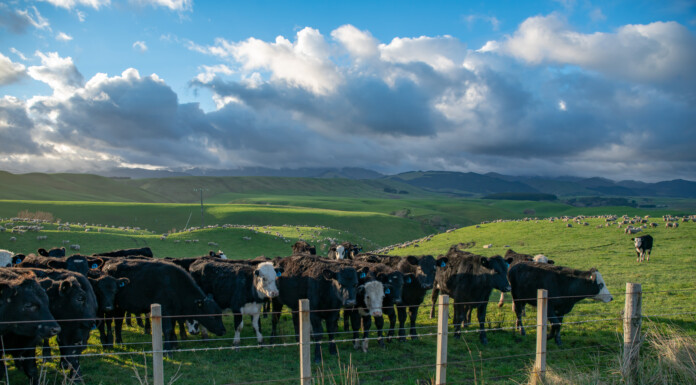As farmers wait for the new coalition government to decide about agriculture regulations, added cost pressures to meet voluntary greenhouse gas [GHG] emission targets set by dairy companies could be on the horizon.
According to Rabobank dairy analyst Richard Scheper, adopting on-farm GHG emissions reduction measures is critical if dairy companies are to reach their climate targets for 2030 and beyond.
“Reductions originating from productivity and efficiency gains may diminish over time, and gains from new technologies may take years to achieve,” Scheper said.
A recent Rabobank report said that due to inflationary pressures, soaring input costs, and surging interest rates adding further challenges, a “well-balanced combination of incentivising carrots and potentially corrective sticks to accelerate the on-farm adoption” is necessary.
Dairy companies are “in a delicate position to balance the interests of their milk suppliers, off-takers, and other stakeholders while tracking other sustainability targets and maintaining healthy margins”, the report said.
Reducing “GHG emissions, especially … emissions that happen on the farm, has been on the agenda of leading dairy companies for several years alongside setting voluntary decarbonisation targets”.
Dairy companies that set voluntary targets are subject to reputational and litigation risks if they aren’t achieved, the report noted.
“Their market access could also be restricted or limited if competitors are meeting their targets and if the market demands that companies do so.
“With the growing need for incentives going forward, it’s of the utmost importance that all parties and stakeholders in the value chain contribute financially to these efforts.
“From the farm to the end consumer, plus [local] governments via stimulating subsidies [carrots] and/or taxes [sticks] and other stakeholders, such as banks.”
Chris Lewis, managing director of Masterton-based agricultural consultancy BakerAg NZ said the Rabobank report reflects the known changes in the international market and responses from large processors like Nestle.
Research shows that the “informed” international consumer wants a product with less GHG emissions, Lewis said.
“In turn, the likes of Nestle say, ‘to be transparent, we need to understand our footprint, which is a function of what our milk suppliers are doing’.”
Lewis noted that the New Zealand companies supplied by local dairy farmers – including Fonterra – all sell to Nestle.
“Tracking of greenhouse gas production is in play through initiatives like Fonterra’s Co-operative Difference, which incentivises reliable recording and reporting,” he said.
“Open Country, Miraka, and Synlait have similar programmes in play.”
Lewis said that farmers who are good with their recording and reporting get premiums – or “carrots” from companies like Fonterra.
He believes proposals like the “virtually defunct” government system He Waka Eke Noa [HWEN] with its tax on emissions – regulated by the NZ Emissions Trading Scheme – is a “stick” that farmers would react to if or when it is implemented.
“Until we see HWEN replacement, it is difficult to predict what will come next in terms of farmer response – a mix of stick and carrot will inevitably happen,” he said.
That said, Lewis also noted that “NZ emissions per unit of milk produced” – the ‘emissions intensity’ – “is among the lowest in the world”.
‘Gross emissions’, meanwhile, count the GHG produced but fail to account for the product that’s created in the process, Lewis said.
“Internally, NZ is being politically challenged about the proportion of emissions that relate to farming – livestock belching methane.
“We are proportionately high in the agriculture sector for gross emissions.”
But, Lewis said, although gross emissions are high in farming by domestic standards, NZ’s total emissions on a world scale are less than 0.5 of one per cent.
“NZ farmers need the politicians and public at large to appreciate the difference between gross emissions and emissions intensity,” he said.
Lewis believes local communities should support farmers who are prepared to stand up and are backed up by good science.
“Wairarapa farmers are building their knowledge and awareness,” he said.
“We have some really good leadership in our community.
“We’re vocal, we read, we learn, we think, and we respond.”
Prime Minister Chris Luxon said in his State of the Nation speech in February that New Zealand had been “badly let down by a broken and distracted government”.
“It tied down our economy with unnecessary regulation and saw farmers and businesses as something to be sneered at rather than celebrated,” he said.
Luxon’s comment followed National’s promise “to end Labour’s war on farmers” and the release of its “Getting Back to Farming” policy package of 19 changes to both “back” farmers and protect the environment.
The policy explicitly recognised agriculture as the backbone of the New Zealand economy.
“National understands how important farming is to rural communities and to lifting New Zealand’s earnings,” it stated.
“Last year, 63 per cent of goods exported from New Zealand came from agriculture.
“Agriculture employs one in nine workers.
“Farmers deserve recognition for their efforts to reduce their environmental footprints.
“Their livelihoods and the legacy they leave depend on them protecting their environment.
“Additionally, New Zealand has among the world’s most carbon-efficient farmers.”
It remains to be seen how National’s policy is reflected by the coalition government’s approach to agricultural regulations.


